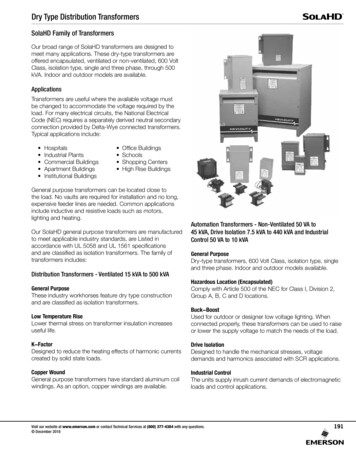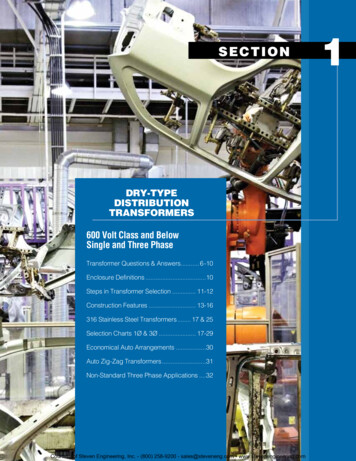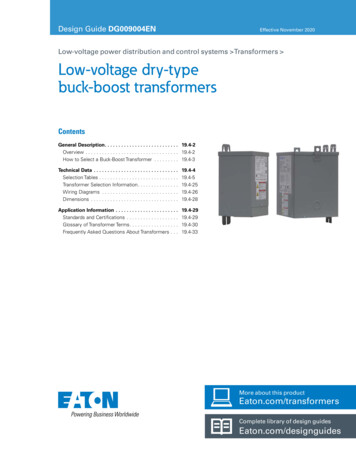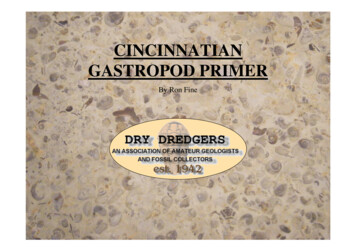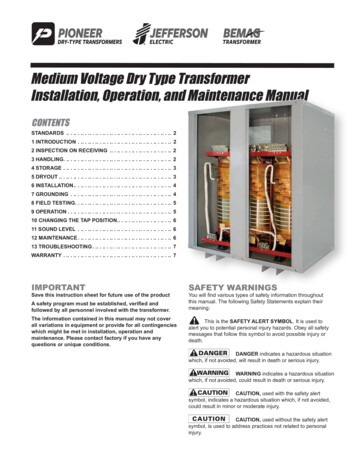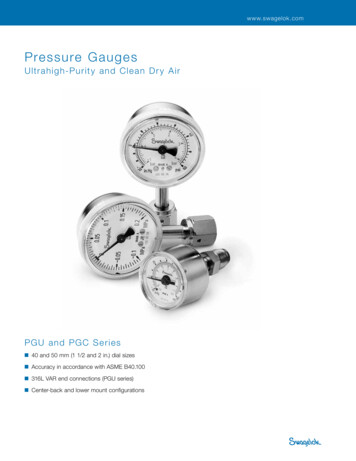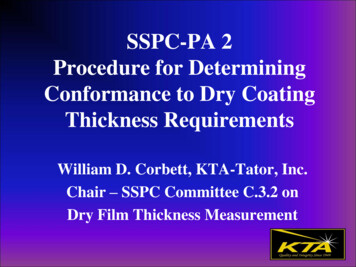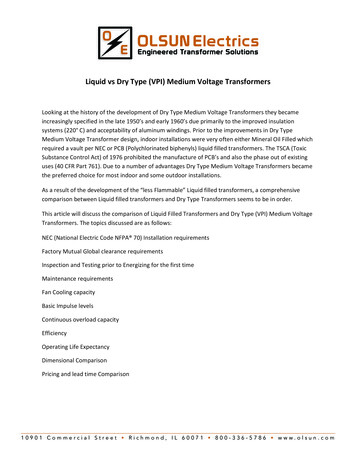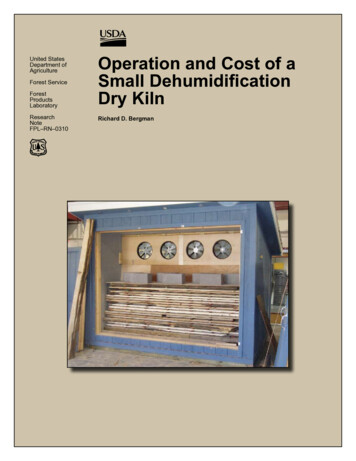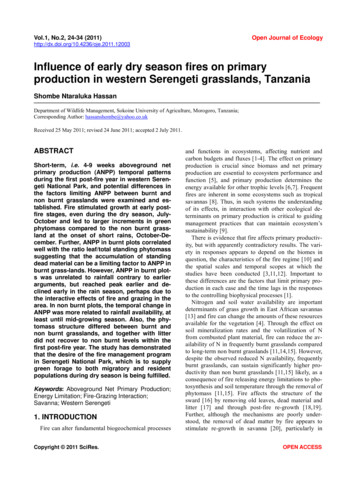
Transcription
Vol.1, No.2, 24-34 (2011)Open Journal of luence of early dry season fires on primaryproduction in western Serengeti grasslands, TanzaniaShombe Ntaraluka HassanDepartment of Wildlife Management, Sokoine University of Agriculture, Morogoro, Tanzania;Corresponding Author: hassanshombe@yahoo.co.ukReceived 25 May 2011; revised 24 June 2011; accepted 2 July 2011.ABSTRACTShort-term, i.e. 4-9 weeks aboveground netprimary production (ANPP) temporal patternsduring the first post-fire year in western Serengeti National Park, and potential differences inthe factors limiting ANPP between burnt andnon burnt grasslands were examined and established. Fire stimulated growth at early postfire stages, even during the dry season, JulyOctober and led to larger increments in greenphytomass compared to the non burnt grassland at the onset of short rains, October-December. Further, ANPP in burnt plots correlatedwell with the ratio leaf/total standing phytomasssuggesting that the accumulation of standingdead material can be a limiting factor to ANPP inburnt grass-lands. However, ANPP in burnt plots was unrelated to rainfall contrary to earlierarguments, but reached peak earlier and declined early in the rain season, perhaps due tothe interactive effects of fire and grazing in thearea. In non burnt plots, the temporal change inANPP was more related to rainfall availability, atleast until mid-growing season. Also, the phytomass structure differed between burnt andnon burnt grasslands, and together with litterdid not recover to non burnt levels within thefirst post-fire year. The study has demonstratedthat the desire of the fire management programin Serengeti National Park, which is to supplygreen forage to both migratory and residentpopulations during dry season is being fulfilled.Keywords: Aboveground Net Primary Production;Energy Limitation; Fire-Grazing Interaction;Savanna; Western Serengeti1. INTRODUCTIONFire can alter fundamental biogeochemical processesCopyright 2011 SciRes.and functions in ecosystems, affecting nutrient andcarbon budgets and fluxes [1-4]. The effect on primaryproduction is crucial since biomass and net primaryproduction are essential to ecosystem performance andfunction [5], and primary production determines theenergy available for other trophic levels [6,7]. Frequentfires are inherent in some ecosystems such as tropicalsavannas [8]. Thus, in such systems the understandingof its effects, in interaction with other ecological determinants on primary production is critical to guidingmanagement practices that can maintain ecosystem’ssustainability [9].There is evidence that fire affects primary productivity, but with apparently contradictory results. The variety in responses appears to depend on the biomes inquestion, the characteristics of the fire regime [10] andthe spatial scales and temporal scopes at which thestudies have been conducted [3,11,12]. Important tothese differences are the factors that limit primary production in each case and the time lags in the responsesto the controlling biophysical processes [1].Nitrogen and soil water availability are importantdeterminants of grass growth in East African savannas[13] and fire can change the amounts of these resourcesavailable for the vegetation [4]. Through the effect onsoil mineralization rates and the volatilization of Nfrom combusted plant material, fire can reduce the availability of N in frequently burnt grasslands comparedto long-term non burnt grasslands [11,14,15]. However,despite the observed reduced N availability, frequentlyburnt grasslands, can sustain significantly higher productivity than non burnt grasslands [11,15] likely, as aconsequence of fire releasing energy limitations to photosynthesis and soil temperature through the removal ofphytomass [11,15]. Fire affects the structure of thesward [16] by removing old leaves, dead material andlitter [17] and through post-fire re-growth [18,19].Further, although the mechanisms are poorly understood, the removal of dead matter by fire appears tostimulate re-growth in savanna [20], particularly inOPEN ACCESS
S. N. Hassan / Open Journal of Ecology 1 (2011) 24-34grassland patches [21]. Contrarily, fires can reduceabove-ground net primary production (ANPP) by controlling the amount of total biomass and photosyntheticarea, which are typically low immediately after the fire[22]. During this phase, primary production can increase steadily before levelling off at a full-developedsward [23].Rainfall is a critical factor controlling biomass andprimary production in savannas [5,7,24,25,26]. Aboveground net primary production is strongly correlatedwith mean annual precipitation in Serengeti grasslands[27] and in other African grasslands, and phytomassproduction follows within-year (monthly) variation inrainfall [28]. Further, the rate of post-fire recovery ofthe vegetation has been observed to correlate with therainfall [4,29]. However, fire through its effect on thevegetation and litter cover [17a], can reduce the amountof water availability in the soil by increasing runoff andreducing infiltration [30] which can lead to comparatively lower net primary production in burnt grasslands[15,17].Despite a relatively large number of studies about theeffects of fire on semi-arid grasslands and savannas, thecurrent understanding of the processes determiningfire-mediated ANPP is insufficient to establish the keycontrolling factors in each case. Most evidence including [10] and [20] refer to long term differences amongfire regimes in terms of frequency of burning. Fewerstudies such as [4] and [22] have focused on the development during early (first year) stages of the swardrecovery, when important differences in the amount ofgreen biomass and in the degree of sward shading areexpected to be determinants of production. This knowledge is critical to understanding the factors that limitcarbon fixation in frequently burnt systems.Although Serengeti National Park has a long historyof more quantitative ecological research in Africa,comparatively little work has been directed to understanding the effects of fire in this system. So far, burning practices in the area are conducted without properunderstanding about the influence of early dry seasonburns on ANPP in grasslands. Equally, the relationshipbetween the post-fire sward development and ANPP isunknown. The combined effects of fire, other disturbances such as grazing and rainfall on grassland ANPPare also largely unknown for the Serengeti and forother semi-arid systems with large wild herbivorepopulations.In this study, the influence of early dry-season burning on grassland productivity in western Serengeti National Park was assessed by establishing short-term (4 9 weeks) temporal patterns of ANPP during the firstpost-fire year. The aim was to test hypotheses aboutCopyright 2011 SciRes.25water availability and photosynthetic limitations onANPP between burnt and non burnt grasslands, and toestablish whether there is a correspondence betweenANPP and rainfall, and between ANPP and swardstructure attributes i.e. quantity and proportions of liveleaf, flowers/fruits and standing dead material in thetwo strata It was hypothesised that: 1) The smallamount of photosynthetic biomass is a constraint toANPP during the early stages of post-fire sward recovery. 2) ANPP would increase in burnt grasslands alongwith sward development and would reach levels higherthan in non burnt grasslands. 3) Also, in the burntgrassland ANPP would increase with rainfall whereasshading would set a limit for productivity in the nonburnt grassland. 4) Amount of phytomass and litter inburnt grasslands will not reach steady-state levelswithin one year of post-fire sward recovery.2. METHODS2.1. Study SiteThe study was conducted in the Western Corridor ofSerengeti National Park (SNP). Serengeti is situatedbetween 1 and 3 30' S, and 34 and 36 E [31]. The SNP(14763 km2) is the main part of the 25000 km2 largeSerengeti ecosystem which extends to the Masaai Marain Kenya [32], and is characterised by annual movements of migratory wildebeests (Connochaetes taurinusThomas), zebras (Equus burchelli Matschie), Thomson’sgazelles (Gazella thomsoni Günther) and elands (Taurotragus oryx Lydekker) [7,31]. Generally, the migrantsspend the wet season, December-May in the South EastPlains and the dry season, August-October in northernSerengeti and Masaai Mara area in southern Kenya. TheWestern Corridor is primarily used by migrating herdswhile moving between dry and wet season grazinggrounds. Wildebeest, Burchell’s zebra, Thomson’s gazelle, African buffalo (Syncerus caffer Sparrman) andtopi (Damaliscus korrigum Matschie) are the key grazing species [27]. Annual rainfall ranges between ca 600mm in the Southeast Plains and ca 1100 mm in the north[33], and averages 700 mm. The rainfall distribution isbimodal, with a period of short rains from November toDecember and the main rain season from March to May[25].2.2. Sampling ProcedurePhytomass dynamics and ANPP were assessed in theperiod from 5th July 2003 to 21st July 2004 by repeatedharvesting of samples taken at intervals of 2 to 9 weeks(Table 1). Study sites (n 6) were in the main area ofthe wildebeest migratory route. Each site consisted ofOPEN ACCESS
S. N. Hassan / Open Journal of Ecology 1 (2011) 24-3426Table 1. periods for phytomass change assessments from July2003 to July 2004, with shortenings and mean time interval indays between consecutive samplings on burnt and non burntplots in six sites in the Western Corridor, Serengeti NationalPark. Average rainfall for whole months in the sampling periodcalculated on monthly records at the stations Nyaruswiga,Mareo and Musabi in Serengeti National Park.PeriodShortenings of 3731613811Rainfallmm/month35485810098815121Sorted materials were air-dried for two weeks in paperbags and later oven-dried at 70 C [36] for 48 hrs andthen weighed using a digital scale (Soehnle ultra, [Leifheit AG. D-56377 Nassau, Germany] with maximum 200g, d 0.1 g precision). A total of 1152 samples werecollected. Seventy-two samples were lost due to twowildfires which burnt four plots, the first one in May andthe second one in June. Monthly rainfall data from thestations Nyaruswiga, Mareo and Musabi with the Serengeti National Park Ecological Monitoring Department(Table 1) were averaged for the months on which ANPPwas calculated (Table 5). Each station consists of onerain gauge and the distance between the sites and therain gauge varied between 0.5 - 1.2 km.2.3. Data Analysesone burnt and one non burnt grassland patch, with eachgrassland patch measuring at least 10 ha in size. Thegrassland patches were either contiguous or oppositeeach other to ensure that they were similar in the generalaspect of the landscape. One plot (50 m 50 m) wasestablished in each burnt and non burnt grassland patchat each of the 6 sites, making twelve main plots in total.Therefore, the plots were in medium-high Themedagrasslands with Themeda triandra, Pennisetum mezianum and Digitaria macroblephara [34] as dominant grassspecies. The distance between the study sites rangedbetween 1 and 40 km, and the distance between the plotsand the closest road ranged between 0.45 and 0.75 km.The burnt patches were burnt during the annual earlydry-season burning operations in May-July 2003 performed by the Serengeti Ecological Monitoring Program(SEMP) unit.Movable cages were used to temporarily exclude largeherbivores from the quadrats between samplings occasions. The cages were conical in shape with 1 m2 (1 m 1 m) base on the ground and 2 m tall. On the first sampling time (T0), in each of the twelve plots, phytomassand litter samples were collected in 6 randomly distributed quadrats of 0.625 m2 each [35] in total 72 samples(6 samples 12 plots). Phytomass were hand-clipped toground level. At the same time six cages were erectedover other randomly selected quadrats. From each of thetwelve plots, at each sampling time from T1 onwards(time T1 - T8), six “fenced” and six “open” phytomasssamples, in total 12 samples were collected (in total 144samples). After clipping the cages were moved to newrandomly selected quadrats.Phytomass samples were hand-sorted into five compartments: live leaf, live stem (referring to grass reproductive culms without the leaves), flower/fruit, standingdead (dead material attached to living plants and deadmaterial that remained attached to the ground) and litter.Copyright 2011 SciRes.Differences in phytomass between open (Ti) andfenced (Ti 1) samples were tested with univariateANOVAs independently for each phytomass componentand sampling occasion, T (T 0 to 8). Since the lengthof the interval between two consecutive samplings varied among samplings, ‘Sampling interval’, in days wasincluded in the model as a covariate (Table 1). Themodel included burnt and non burnt as main treatmentsplots (Fire), ‘Phytomass change’ (fenced, Ti 1 vs. open,Ti), ‘plot’, the interaction term ‘Phytomass change *Fire’and ‘Sampling interval’. ‘Fire’ and ‘Phytomass change’were fixed factors, and ‘plot’ random. The analyses wereconducted using the General Linear Model-UnivariateANOVA routine in SPSS v. 15 for windows [37]. Significant positive differences in total above-ground phytomass (including litter) between fenced samples, Ti 1and open samples, Ti indicated phytomass gain (production). A significant interaction effect of ‘Phytomasschange*Fire’ indicated differences in production between burnt and non burnt plots.Daily ANPP in each fire treatment was calculated asthe phytomass increment, i.e. the positive difference intotal phytomass (live, standing dead and litter) betweenconsecutive samplings divided by the number of daysbetween samplings. Phytomass increments were basedon plot averages, i.e. on 6 open and 6 fenced samplesrespectively. The structural attributes of the sward, i.e.the amount of leaf, stem, flower-fruits, standing deadmaterial and litter, and the ratios of phytomass compartments were computed for the eight sampling periods(T1 - T8) on the ‘fenced’ samples. Pearson correlations(tow-tailed significance test) were calculated betweenthe daily ANPP and the average sward attributes pertreatment using the correlations routine in SPSS v. 15.0.Phytomass ratios were calculated on each sample andarcsine transformed for the ANOVAs and Pearson correlations. Data which showed skewed distribution wereOPEN ACCESS
S. N. Hassan / Open Journal of Ecology 1 (2011) 24-34square-root transformed to improve normality and variance homocedasticity [37].3. RESULTS3.1. Fire, Sward Structure and PhytomassAllocationsTotal above-ground phytomass (including litter) wasat all sampling times higher in the non burnt plots thanin the burnt plots with averages of ca 301.5 gm–2 and ca151.3 gm–2, respectively (Table 2). The differences weresignificant in six of the eight periods. Total live phytomass was also generally larger in non burnt plots, differing significantly at four occasions. Phytomass of leaf,stem and flower/fruit were significantly higher in nonburnt plots at 3, 5 and 2 sampling times, respectively.Only in June was the phytomass of flower/fruits higherin the burnt plots (Table 2). Mean total live biomass was123.2 gm–2 and 87.0 gm–2 for non burnt and burnt plots,respectively.Fire had an effect on the temporal distribution of livephytomass. The peaks for live leaf and total live phytomass differed between treatments. It was highest inburnt plots for live leaf during December and for totallive phytomass in non burnt plots during February (Table 2 and Figure 1). Also the first peak in live stemphytomass, related to the reproductive phase in grasses,was earlier in burnt plots, December than in non burntplots, February (Table 2). In contrast, the phytomass offlowers/fruits followed similar temporal patterns in burntand non burnt plots with peaks in December, May andJuly.27Fire had also an effect on the amount of plant debris.There was more standing dead phytomass and litter innon burnt plots than in burnt plots at all times (Table 2and Figure 1). In both treatments, standing dead phytomass increased steadily during the early stages of thegrowth season with first peak in December (Table 2),and a significant net accumulation in February-March(Figure 1) after the short rain. Non burnt plots had asecond peak at the end of the long rain-season, in July.Further, fire changed the relative phytomass compositionof the sward (Table 3). Burnt plots had significantlyhigher ratios of live leaf/total standing phytomass inOctober, December and February; significantly lowerratios of live stem/total standing phytomass at earlypost-fire stages (September and October), and higherratios of total live/total standing phytomass (Decemberand February). Non burnt plots had generally higherstanding dead/total above ground phytomass ratios.Fire also changed the relative distribution of live phytomass, between vegetative and reproductive structures(Table 4). Burnt plots had significantly higher ratios oflive leaf/total live phytomass (October and February),and generally lower ratios of live stems plus flower-fruitsphytomass/total live phytomass, were significantly lowerat five sampling times. There were no differences between treatments in the ratios of flower and fruit phytomass/total live phytomass.3.2. Variation in ProductivityTotal live phytomass changed significantly betweensampling periods, i.e. at the end of the dry season (September-October), during the short rains (DecemberFebruary) and during the long rains, March-JuneTable 2. Mean values (raw scores-gm–2) of total aboveground mass (including litter), total standing phytomass and phytomass compartments: live leaf, live stem, flower and fruit, total live, standing dead, and litter in fenced samples in burnt and non burnt plots inWestern Corridor grasslands, Serengeti National Park from September 2003 to July 2004.Sampling timeTreatmentSepBurntNon burntBurntNon burntBurntNon burntBurntNon burntBurntNon burntBurntNon burntBurntNon burntBurntNon 563.210.718.8Live 7.75.444.00.4*65.20.017.83.330.84.6Dead .715.0**27.210.2*34.6* Difference between burnt and non burnt plots in plant mass statistically significant at P 0.05; ** P 0.001.Copyright 2011 SciRes.OPEN ACCESS
S. N. Hassan / Open Journal of Ecology 1 (2011) 24-3428Table 3. Mean ratios (raw scores) of phytomass compartments in fenced samples on burnt and non burnt plots in six sites in theWestern Corridor, Serengeti National Park, from September 2003 to July 2004. Live leaf, live stem and total live is shown in relationto total standing phytomass (live attached dead plant material), and standing dead material and litter in relation to totalabove-ground Live leaf/total standing BurntNonburntLive stem/total standing phytomassTotal live/totalstanding phytomassStanding dead/totalabove-ground massLitter/total 0.3230.188
Serengeti National Park (SNP). Serengeti is situated between 1 and 3 30' S, and 34 and 36 E [31]. The SNP (14763 km. 2) is the main part of the 25000 km large Serengeti ecosystem which extends to the Masaai Mara in Kenya [32], and is characterised by annual move-ments of migratory wildebeests (Connochaetes taurinus . Thomas), zebras

